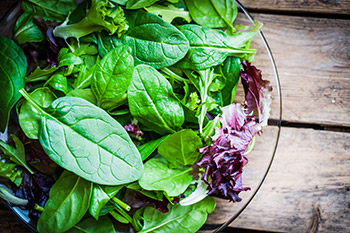Spinach | Superfood of the Month

Description & Health Benefits
- Spinach is a member of the Amaranthaceae family, and was formally in the Chenopodiaceae family until 2003 when the Chenopodiaceae family merged into the Amaranthaceae family.
- It varieties vary by size, shape, and texture. Spinach grows best in the spring and fall when the temperatures are cool.
- Spinach has many health benefits. Besides being low in calories (only 7 calories per 1 cup of raw spinach) it is high in Vitamins A, C, and K, and folate as well as being a good source of iron and magnesium.
- Vitamin A is important for immune system health, vision, and reproduction.
- Vitamin C aids in the absorption of iron and wound healing.
- Vitamin K is vital for healthy bones and blood clotting.
- Folate protects against neural tube defects in pregnant women.
- Iron is required for growth, development, and assists in making red blood cells.
- Magnesium regulates nerve and muscle function, and blood pressure.
Selecting, Storing, and Preparing
- Choose green, fresh bunches of spinach which are not wilted and are without signs of insect damage. Discard any leaves that are yellow.
- Store in a clean plastic bag and refrigerate until use. Spinach should be consumed within 2-3 days after purchase and is best when eaten fresh.
- Young spinach stems will be tender and flexible whereas more mature spinach stems are thick and tough. Remove stems, especially thick ones prior to cleaning spinach.
- Clean spinach by soaking it in a large bowl of cold water for a few minutes. Swish spinach around the water to remove dirt and sand. Once thoroughly washed, remove spinach and drain in a colander. Dirt and sand tends to stick to spinach, so repeat the above process if necessary and re-rinse in new, fresh, cold water. Let spinach dry prior to preparing your dish by patting with paper towels or letting sit in colander for 10 minutes.
- To freeze it, take dry, clean spinach, place in a freezer baggy, and press air out of the baggy. Label with date and put in the freezer. Use for recipes that call for spinach in a cooked form.
- To cook it, boil, sauté, bake, or eat raw.
- To boil, place in a large pot of boiling water, cook 3-5 minutes, drain, and eat.
- To sauté, heat a pan with olive oil over medium heat; add spinach and cook until it wilts, stirring, about 2-3 minutes. Lastly, season with your favorite herbs and spices to taste.
- Use raw spinach as a base for your favorite salads.
Nutrition Facts
1 cup raw
Calories: 7.0 | Protein: 0.86 g | Fat: 0.12 g | Carbohydrate: 1.09 g | Fiber: 0.7 g | Sugars: 0.13 g | Calcium: 30 mg | Magnesium: 24 mg | Potassium: 167 mg | Vitamin C: 8.4 mg | Folate: 58 µg | Vitamin A: 2813 IU |Vitamin K: 144.9 µg
1/2 cup cooked
Calories: 21.0 | Protein: 2.67 g | Fat: 0.23 g | Carbohydrate: 3.38 g | Fiber: 2.2 g | Sugars: 0.39 g | Calcium: 122 mg | Magnesium: 78 mg | Potassium: 419 mg | Vitamin C: 8.8 mg | Folate: 131 µg | Vitamin A: 9433 IU | Vitamin K: 444.2 µg

